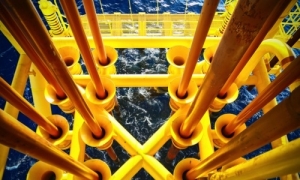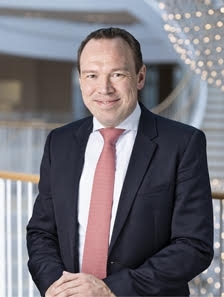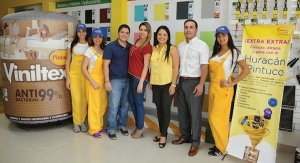Sean Milmo, European Correspondent01.06.17
Investment in coatings has been faltering in Europe in response to slow or static growth in demand. Even in Eastern Europe whose economies have been more dynamic than those in Western Europe investors have been reluctant to put new funds into expansions in coatings.
Instead Europe-based coatings companies have had to seek investment opportunities outside the region, in particularly in faster growing areas on its periphery like the Middle East and its oil- and gas-rich states in the Gulf.
The economies of the six Arab countries in the Gulf Cooperation Council (GCC) – Saudi Arabia, United Arab Emirates (UAE), Kuwait, Qatar, Bahrain and Oman – have been starting to recover from the impact of the sharp fall in the prices of crude oil two years ago.
The average growth rates of GDPs of the GCC states—all oil exporting countries – together with that of Algeria, another large Mid-East oil producer, are expected to rise from less than 2 percent last year to around 3 percent annually in 2016 and 2017, according to the International Monetary Fund (IMF). However, this compares with an average of 7.75 percent in the ten years to 2015.
Nonetheless despite the decline in economic growth, the demand for coatings in the Gulf has stayed relatively strong mainly due to a revival in the region’s construction sector and in the need for protective and industrial coatings.
The construction market is being driven by the increase in new residential housing to meet rising living standards and in infrastructure such as airports and rail stations and new cities. In Qatar nine new stadiums are due to be built and three renovated in preparation for the soccer World Cup in 2022.
The GCC countries also have ambitious plans to diversify their economies by becoming less dependent on revenues from oil and petrochemical exports. This is to be achieving by branching out into downstream manufacturing using petrochemical derivatives as raw materials for a variety of consumer and industrial products which will open up new sectors for industrial coatings.
At the same time Iran is going through an economic revival following the lifting of sanctions in the wake of an international deal on its nuclear plans, boosting coatings sales across a range of sectors.
For European and other investors in the Gulf coatings market, the only major concern are that the continued volatility of the global oil market could undermine the Gulf economies once again. Also there is the danger that political strife, particularly between the Arab countries and Iran, could also trigger an economic crisis.
“The Gulf economies are on the way up at the moment and hopefully that will continue,” said Jarkko Mattila, export director at Tikkurila of Finland, which has just been expanding into the Gulf. “But an economic downturn throughout the region could happen quite rapidly.”
Tikkurila is moving into Gulf region for the first time with the launch in 2016 of a number of decorative, wood, flooring and industrial coatings through a distributor based in Dubai in the UAE.
“One of our main reasons for entering the Middle East is the stagnation in the coatings market in Europe,” explained Mattila. “We are well established in Europe, particularly Eastern Europe, including Russia. We’ve also been doing well in China. Now it is time to take advantage of the opportunities in the Gulf.”
By contrast most of the European companies which are currently strengthening their presence in the Gulf have been in the region for many years.
Jotun of Norway has just inaugurated a coating plant in Oman 40 years after it opened its first production facility in the region in Dubai.
Now it is a major force in the Gulf’s market for oil and gas, marine and other protective coatings as well as having made big inroads into the regional decorative paints sector.
It is currently positioning itself to benefit from the diversification of the region’s economies. The opening of the new facility in Oman showed the company’s “commitment to the country’s ambition to develop into a diversified economy with increased investments and focus in the manufacturing sector,” said Anwar Ali Sultan, Jotun Paints Oman’s chairman.
Hempel, the Danish protective and decorative coatings producer, is aiming to open in 2017 an expansion of a plant at Jeddah’s Second Industrial City in Saudi Arabia in which it will consolidate all its output for the country’s coatings market. The company is planning to use the additional capacity to double its market share in Saudi Arabia, which in line with the dominant size of its economy is the biggest coatings market in the GCC.
In neighboring Kuwait, Hempel is due to bring on stream a new coatings plant in 2017 which will replace an existing plant in the country built in the 1960s after the company first entered the Middle East market. The unit which will have 45 percent more capacity will reinforce Hempel’s leading position in the country’s coatings sector.
AkzoNobel which has a number of powder coatings plants in the region has recently set up three joint ventures in the Gulf with local partners to help it maintain a double-digit average growth in GCC coatings sales.
Like most other European coatings companies in the GCC, it follows a sustainability strategy with the emphasis on products which reduce carbon footprints and have low emissions of volatile organics compounds (VOCs)
Despite their continued reliance on crude oil exports, the GCC states have been becoming increasingly aware of the need to protect the environment. The Gulf is a “fast growing region (which) ensures that companies adopt and follow a strict sustainability agenda,” Peter Tomlinson, managing director of AkzoNobel Middle East, said in a recent interview with a local newspaper.
However as the GCC countries move downstream into the manufacture of electrical and electronic appliances, automobiles and their components and even oil and petrochemical tankers, they want to create their own indigenous coatings industry. This will have the advantage of being able to produce coatings from local petrochemical-derived raw materials.
In Saudi Arabia, which has the most far reaching plans for downstream industries, Sadara Chemical Co., a recently inaugurated $20 billion giant petrochemicals complex at Jubail Industrial City with 26 manufacturing units is already producing coatings and adhesives raw materials.
The project is a joint venture between Saudi Aramco, the state oil company, and Dow Chemical with Dow providing research support through the building of a Dow Middle East R&D Centre at a top Saudi university.
This could be the pattern of the future in the Gulf. European and other Western companies will be expected to supply not just quality coatings but also the expertise and technologies to help GCC businesses make their own high performance coatings as well.
Instead Europe-based coatings companies have had to seek investment opportunities outside the region, in particularly in faster growing areas on its periphery like the Middle East and its oil- and gas-rich states in the Gulf.
The economies of the six Arab countries in the Gulf Cooperation Council (GCC) – Saudi Arabia, United Arab Emirates (UAE), Kuwait, Qatar, Bahrain and Oman – have been starting to recover from the impact of the sharp fall in the prices of crude oil two years ago.
The average growth rates of GDPs of the GCC states—all oil exporting countries – together with that of Algeria, another large Mid-East oil producer, are expected to rise from less than 2 percent last year to around 3 percent annually in 2016 and 2017, according to the International Monetary Fund (IMF). However, this compares with an average of 7.75 percent in the ten years to 2015.
Nonetheless despite the decline in economic growth, the demand for coatings in the Gulf has stayed relatively strong mainly due to a revival in the region’s construction sector and in the need for protective and industrial coatings.
The construction market is being driven by the increase in new residential housing to meet rising living standards and in infrastructure such as airports and rail stations and new cities. In Qatar nine new stadiums are due to be built and three renovated in preparation for the soccer World Cup in 2022.
The GCC countries also have ambitious plans to diversify their economies by becoming less dependent on revenues from oil and petrochemical exports. This is to be achieving by branching out into downstream manufacturing using petrochemical derivatives as raw materials for a variety of consumer and industrial products which will open up new sectors for industrial coatings.
At the same time Iran is going through an economic revival following the lifting of sanctions in the wake of an international deal on its nuclear plans, boosting coatings sales across a range of sectors.
For European and other investors in the Gulf coatings market, the only major concern are that the continued volatility of the global oil market could undermine the Gulf economies once again. Also there is the danger that political strife, particularly between the Arab countries and Iran, could also trigger an economic crisis.
“The Gulf economies are on the way up at the moment and hopefully that will continue,” said Jarkko Mattila, export director at Tikkurila of Finland, which has just been expanding into the Gulf. “But an economic downturn throughout the region could happen quite rapidly.”
Tikkurila is moving into Gulf region for the first time with the launch in 2016 of a number of decorative, wood, flooring and industrial coatings through a distributor based in Dubai in the UAE.
“One of our main reasons for entering the Middle East is the stagnation in the coatings market in Europe,” explained Mattila. “We are well established in Europe, particularly Eastern Europe, including Russia. We’ve also been doing well in China. Now it is time to take advantage of the opportunities in the Gulf.”
By contrast most of the European companies which are currently strengthening their presence in the Gulf have been in the region for many years.
Jotun of Norway has just inaugurated a coating plant in Oman 40 years after it opened its first production facility in the region in Dubai.
Now it is a major force in the Gulf’s market for oil and gas, marine and other protective coatings as well as having made big inroads into the regional decorative paints sector.
It is currently positioning itself to benefit from the diversification of the region’s economies. The opening of the new facility in Oman showed the company’s “commitment to the country’s ambition to develop into a diversified economy with increased investments and focus in the manufacturing sector,” said Anwar Ali Sultan, Jotun Paints Oman’s chairman.
Hempel, the Danish protective and decorative coatings producer, is aiming to open in 2017 an expansion of a plant at Jeddah’s Second Industrial City in Saudi Arabia in which it will consolidate all its output for the country’s coatings market. The company is planning to use the additional capacity to double its market share in Saudi Arabia, which in line with the dominant size of its economy is the biggest coatings market in the GCC.
In neighboring Kuwait, Hempel is due to bring on stream a new coatings plant in 2017 which will replace an existing plant in the country built in the 1960s after the company first entered the Middle East market. The unit which will have 45 percent more capacity will reinforce Hempel’s leading position in the country’s coatings sector.
AkzoNobel which has a number of powder coatings plants in the region has recently set up three joint ventures in the Gulf with local partners to help it maintain a double-digit average growth in GCC coatings sales.
Like most other European coatings companies in the GCC, it follows a sustainability strategy with the emphasis on products which reduce carbon footprints and have low emissions of volatile organics compounds (VOCs)
Despite their continued reliance on crude oil exports, the GCC states have been becoming increasingly aware of the need to protect the environment. The Gulf is a “fast growing region (which) ensures that companies adopt and follow a strict sustainability agenda,” Peter Tomlinson, managing director of AkzoNobel Middle East, said in a recent interview with a local newspaper.
However as the GCC countries move downstream into the manufacture of electrical and electronic appliances, automobiles and their components and even oil and petrochemical tankers, they want to create their own indigenous coatings industry. This will have the advantage of being able to produce coatings from local petrochemical-derived raw materials.
In Saudi Arabia, which has the most far reaching plans for downstream industries, Sadara Chemical Co., a recently inaugurated $20 billion giant petrochemicals complex at Jubail Industrial City with 26 manufacturing units is already producing coatings and adhesives raw materials.
The project is a joint venture between Saudi Aramco, the state oil company, and Dow Chemical with Dow providing research support through the building of a Dow Middle East R&D Centre at a top Saudi university.
This could be the pattern of the future in the Gulf. European and other Western companies will be expected to supply not just quality coatings but also the expertise and technologies to help GCC businesses make their own high performance coatings as well.





